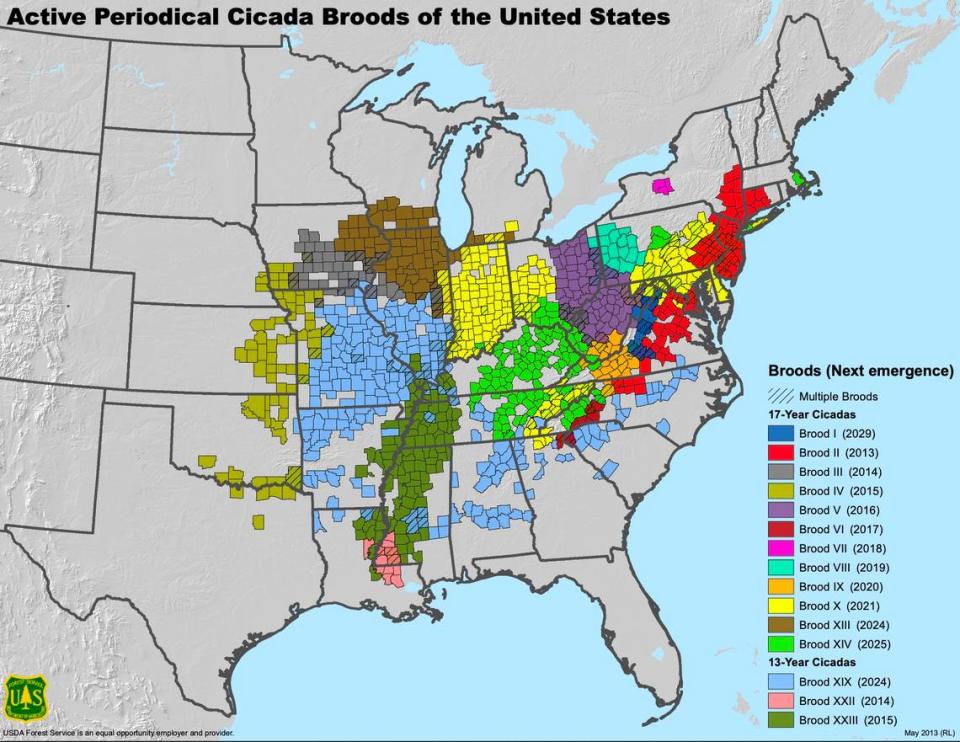A quick bout of warm weather in the Triangle this week is leaving many of us longing for summer’s hot days and the long stretches of daily sunshine that Carolina skies seem to be so good at offering.
But are we ready for the cicadas? Not to freak you out, but two broods of cicadas will be emerging this year, and the total number joining us across the 16-state emergence area will be in the trillions.
Not freaking out, right? Good, because there’s no need to worry about them, said Kelly Oten, NC State Extension entomologist and specialist in the Department of Forestry and Environmental Resources.
“They’re going to be very loud! Just keep in mind, they’re harmless, and it’s temporary,” she said.
“They will sing their loud songs, then soon disappear for another 13 years.”
Here’s what to know about this summer’s cicada emergence, along with some cicada FAQs.
When will cicadas emerge in 2024?
Sometime around May, but it all depends on the weather. Cooler weather leads to a later emergence, and warmer weather pushes it up earlier, Oten said.
The last time this brood emerged in both the Triangle and the Charlotte area was in 2011, and they emerged in early May.
When will cicadas go away?
They’re only around for about a month or so.
If they emerge in early May, they’ll be gone by the end of June, Oten said.
What do cicadas do?
Cicadas are a valuable part of our ecosystem, serving as food for many crawling and slithering critters.
This brood of cicadas have spent the last 13 years of their lives underground, and when they emerge, they sing to one another to find a mate. Then, they lay eggs and die.
These specific cicadas will live on through the eggs they lay this summer.
“Eggs will hatch, and the new cicadas will start their 13-year underground wait for their time to emerge,” Oten said.
Do more cicadas mean more copperheads and other snakes?
It’s possible.
“During a periodical cicada emergence, snake sightings and potentially even population size can increase. That’s a natural predator/prey relationship,” Oten said.
Along with snakes, common cicada predators include birds, raccoonS , squirrels and dogs.
What makes the 2024 cicada emergence special?
Two reasons, Oten said:
-
The two broods of cicadas emerging this year haven’t co-emerged in over 200 years.
-
The Piedmont only experiences a periodical cicada emergence every 13 years.
There are several species of periodical cicadas, which either emerge every 13 or 17 years. It’s not uncommon for 13 and 17-year broods to emerge in the same year, and it last happened in 2015.
But the two specific broods emerging this year haven’t co-emerged since 1803. Across the 16-state emergence range, we can experience trillions of cicadas in 2024, Oten said.

How many Brood XIX cicadas will be in Raleigh or Charlotte?
Definitely not trillions. The Raleigh/Durham and Charlotte areas will only see one of these broods: Brood XIX.
It’s also called “The Great Southern Brood,” Oten said.
These periodical cicadas will come in addition to annual cicadas (frequently known as dog day cicadas), which are much lower in numbers. Dog day cicadas live for one year and arrive a bit later in the summer, overlapping with periodical cicadas by a few weeks.
Brood XIX will emerge north to Illinois, east to the Virginia/North Carolina area and west to Oklahoma. The other brood emerging is Brood XIII, which will emerge from northern Illinois east to Iowa and north to southern Wisconsin.
There’s only a small area in central Illinois where the two broods will geographically overlap, but the vast majority of the emergence area will only be from a single brood, Oten said.
Will the 2024 cicada emergence impact our daily lives?
Just from a noise perspective, Oten said.
“Depending on how many emerge in your specific area, we can expect very loud singing as they search for mates. It’ll probably be pretty annoying to most people.”
You may also see tree damage, as females lay eggs in slits they cut in woody stem tissue of trees. This can lead to branch tips dying. Older trees can usually withstand the damage, but younger trees might get stressed.
It’s typically not noticeable from our annual cicadas, but during a periodical emergence like this one, the damage could be more obvious for observers, she said.
Can cicadas be harmful to pets?
Cicadas aren’t toxic or dangerous to pets, Oten said. (Remember, many dogs eat them.)
They could cause issues if pets consume massive amount of them, but they’re not inherently poisonous.
Cicadas are at their peak — so you may see more copperheads. Snake expert explains
Are copperheads more active in mild and damp weather? We asked snake experts.
Signup bonus from





